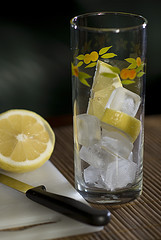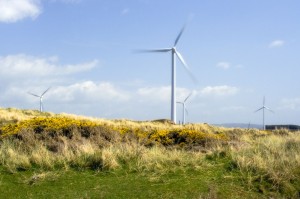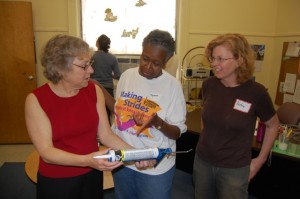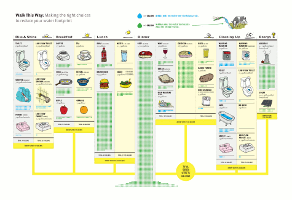Keep this in mind, and consider pointing it out to the management of any businesses you frequent that might be trying to violate the laws of thermodynamics and cool the outdoors. After all, it’s crazy to leave your doors and windows open during the winter, right?
Category Archives: Alternative Energy
Keep your cool
 Here are some ideas to help you keep your cool without cranking the A/C down to 63°:
Here are some ideas to help you keep your cool without cranking the A/C down to 63°:
- If your looking at installing an air conditioner, consider a whole house fan instead. En lieu of a window-mount A/C, opt for a window fan. Of course, if you’re lucky like me, and have two windows, setting a fan in front of one—with the screen out of the way—to blow the hot air out will draw a nice evening breeze in the other; especially if the door is closed.
- Keep your refrigerator and freezer full. The more empty space there is, the more warm air you lock inside after opening and closing the door. Fill soda bottles with water and stick them in the freezer. When you need more room, move them to the refrigerator where their “coolth” will reduce the load on the system.
- Take a brief cold shower before going to bed, and towel off lightly if at all. You may find you don’t need the A/C after all; especially with the aid of a low fan.
- If you have the option, stay-up/sleep in later, this way you’re awake when it’s coolest. Granted, you might use a little electricity so you can see, but a CFL uses much less power than an air conditioner.
- While it’s always a good idea to make sure unused devices are turned off and/or unplugged, it’s especially important in the summer. Any energy a machine does not use to make noise or light or espresso is given off as waste heat. In some cases this can mean the difference between an uncomfortable room and a tolerable one.
Note: This does not mean that it’s a good idea to leave these devices turned on all winter long, electricity is one of the most expensive and least efficient means of heating a room.
Feel free to share any tips you have in the comments below.
BioFuels for your Home-Part II

Last week, Warm Home Cool Planet received a phone call from Dr. Jesse Reich, CEO of Baystate BioFuels, whose company was recently profiled on NECN and on the pages of Warm Home Cool Planet. He provided us with some numbers on the use of BioFuels in the home that will be of interest to anyone who heats their home with oil and wants to reduce their use of non-renewable resources and the amount of CO2 released into the atmosphere.
The average home uses approximately 730 gallons of heating oil each year-and each gallon of Number 2 home heating oil releases 22 lbs of CO2 into the atmosphere. Pure Biodiesel reduces the CO2 generated by approximately 85%. As mentioned previously, Massachusetts law now mandates each load of home heating oil contains 2% of biodiesel, which reduces the amount of CO2 released into the environment by an average of 275 lbs per house this year, and an additional 135 lbs each year the Biofuel blend is raised by an additional percentage point.
Most home furnaces, however, can accomodate a 20% biofuel blend in the oil tank. Each home that uses this B:20 blend will reduce the CO2 emitted by over 2750 lbs a year. Multiply that by the millions of homes in the New England area heated with oil and you’re talking about a truly significant reduction in greenhouse gases.
To get the B:20 Biofuel Blend for your home, contact your heating oil supplier. If you want to know more about BioFuels and their role in reducing greenhouse gases, click here.
First in Music. First in Energy Audits.

Austin, Texas–which we have always considered to be a little slice of Massachusetts right in the middle of the Lone Star state–has become the first town to pass and ratify a law that makes an energy audit mandatory when you sell a home within the city limits.
Almost 400 audits have been performed under the new ordinance which was passed in November 2008 and went into effect June 1 this year. After a furious lobbying effort by the Austin Board of Realtors, homeowners are not required to make all improvements, but the results will likely be used as a bargaining chip in most purchases.
One homeowner found that over 80% of his air-conditioning was leaking through his uninsulated attic and decided to make the repair to improve the prospects of selling his house. In this depressed market, most sellers will be looking for any advantage they can get.
Of course, Austinites have to find an energy auditor and pay for the audit. Luckily, if you live in Cambridge, requesting an audit is as simple as filling out a simple form and in many cases it’s free.
IRENA, soon to be a household name?
In case you missed it last week, among all the pop-culture news coverage and myriad other events, the U.S. has joined a majority of the world’s countries as a member of IRENA. The new International Renewable ENergy Agency. After reading their FAQ I still wasn’t entirely sure what they expected to do, but their press packet was a little more enlightening:
The Agency’s tasks will include, among others,
• working with its member states to improve the policy environment for the use of renewable energy,
• engaging in cooperation on technology transfer issues in the area of renewable energy, and
• supporting capacity building measures in the field of renewable energy.The Agency will advise its member states using an integrated, practice-oriented approach that takes account of country-specific circumstances. To that end, IRENA will pursue specific activities:
• policy advice,
• advice on financing and technology issues, and
• processing and provision of information, including reliable scientific data.
Sounds swell, and I hope that I’m not reading between the lines too much because it sounds like IRENA could actually seek some desperately needed patent reform. The existing system is a mess, and is regarded by many to hinder rather than help progress of the technical arts as the founding fathers initially intended. For instance, last week the Wall Street Journal carried an article about Toyota’s immense Prius patent portfolio, and its impact on the competition.
Whiche’er way the wind blows

Remember T. Boone Pickens and his famous plan? There’s been much buzz today (for example) about an announcement of the downward revision of his original plans to one quarter the original scale. The change has been attributed to lower fossil fuel prices than when the plan was first put forth, as well as the credit crunch. However, Pickens is already on the hook for nearly 700 turbines, and he plans to make several smaller wind farms rather than the megafarm previously proposed. Most people seem to see this as an unfortunate turn of events, but a handful of smaller installations are a more sound strategy from most vantage points e.g; redundancy, minimizing impacts, etc. As for the diminished capacity, initial delivery is not due until 2011, so it there’s probably still time for things to pick back up.
(Update)
P.S. There seems to be a new wind installation in Harvard Square next to The Garage at Dunster & Mount Auburn. Give it a gander next time you’re in the area, and if you forget but it’s gusty out, you might just look up to figure out where that gentle whirr is coming from. (Click the image at right for a better view)
Your heating oil now contains biofuel. It’s the law
It’s a little known fact that this winter will be the first in which Massachusetts requires home heating oil to include at least 2% biofuels, rising 1 percentage point each year until it reaches 5% in 2012. In 2009, that creates a 24 million gallon demand, and Baystate Biofuels is here to fill it.
The company has taken over the disused tanks at an old Western Telecom building in North Andover and it plans to utilize solar power Osgood Landing had previously installed on the site, and Baystate Biofuels will tap into excess steam from a nearby waste-to-energy incinerator to heat the tanks to lower the viscosity of the pure biodiesel.
Warm Home Cool Planet is checking on whether Baystate will be delivering to Cambridge this winter. In the meantime, check out the video above. More on this soon.
Cambridge Community Center gets an Energy Make-Over
The Cambridge Community Center received a major energy efficiency upgrade on Sunday, June 28th Sunday, when community members and experts gathered to reduce the building’s energy consumption. The community “barn-raising” project was a combined effort of the Home Energy Efficiency Team (HEET) and the Cambridge Energy Alliance (CEA) that aimed to improve the comfort and efficiency of the Cambridge Community Center while teaching volunteers energy efficiency and conservation skills.

Councilor Henrietta Davis, CCC member Yvonee Gittens, and HEET leader Audrey Schulman
The project drew approximately 60 community volunteers, primarily from the Riverside neighborhood in Cambridge. A team of eight volunteers from Mass Climate Summer also joined the neighborhood effort as part of their broader campaign to educate residents on efficiency solutions in partnership with the Cambridge Energy Alliance.
Community volunteers learned how to make doors and windows less drafty, seal air leaks in the building, install interior storm windows, and save on electricity through simple changes. They also received energy efficiency kits from the Cambridge Energy Alliance that contained materials to make their own homes more energy efficient and information on community environmental resources and programs. The Cambridge Community Center barn-raising provided a great opportunity to meet neighbors, try out a green job, cut energy bills at the Community Center, and get a free energy savings kit, while learning to save energy and money at home.
Register to attend the next HEET barnraising on Saturday, July 18th from 12:30 – 5:00pm at two homes in Cambridgeport.
TechTV
If you’ve got time and bandwidth to kill, you might want to check out TechTV. In the spirit of OpenCourseWare, MIT hosts videos of various guest lectures and conferences. For instance, Energy forecast for the rest of the century. Although I don’t personally agree with all of the professor’s interpretations—many conflict with the more pragmatic views portrayed in “Sustainable Energy,” which is incidentally available via OCW—it was an interesting presentation, and could probably serve as a good introduction for the uninitiated nevertheless. I also appreciated his putting the scope of human influence in perspective by comparing it with natural flows. It reminded me of prolific environmental author Vaclav Smil’s excellent Cycles of Life : Civilization and the Biosphere.
Ghouls & Gallons
Here’s an interesting graphic showing the amount of energy consumed by some common appliances when not in use, although the distinction between “passive” and “active” loads also seems unnecessary and distracting. Also, this phenomenon is typically called phantom load not “vampire load,” as the artist has dubbed it, after a less common term for wall-warts. Perhaps this even inspired google’s little contribution towards energy frugality last Halloween: The Haunted House? In any event, be sure to multiply the listed costs of these little suckers by a factor of 2 or 3 to to more accurately reflect bills in Cambridge.
Also while surfing this weekend I came across another infographic from progressive magazine GOOD. This one’s a sort of decision tree, comparing water consumption for daily activities. Keep in mind though, that things are not quite as simple as some would like to make them out to be. While it may actually take more water to grow an apple, the devil is in the details. If you’re biting into a Jonagold from Stow in September, then much of the water was rain, and very little gasoline went into transporting it. On the other hand, an orange from a field irrigated with scarce water in California or Florida has a lot of embodied energy. As always caveat emptor.




